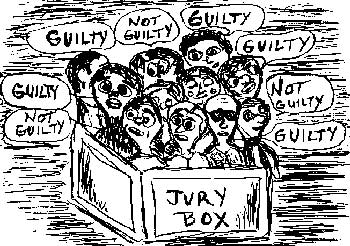Getting What We Deserve: The Depravity Standard
“In a democracy that all too often bemoans unfairness in injustice,
the Depravity Scale’s goal of distinguishing the worst of crimes,
must…incorporate…current diagnostic understandings, the clinical
experience of evil from a range of forensic sciences beyond psychiatry,
and attempts to define evil by law.”
-Dr. Michael Welner, MD
I don’t need to tell you what happened in Boston. This article isn’t about that. It is about the moral and ethical bombs that have been exploding throughout America ever since. “Should they be tried as terrorists?” “Foreign or Domestic?” “Were they more like Loughtner and insane?” “Were they evil?” “What does it matter?”
This moral, ethical and ultimately legal debate has been the focus of the Depravity Standard, Dr. Michael Welner, MD and the 70 person Forensic Panel that he heads for over a decade. I had been preparing this article prior to the Boston Marathon Bombing, the attack simply crystallized the need for a standard that objectively judges the crime itself—not the perpetrators—and determines the level of depravity, or some say evil. Victims deserve justice, perpetrators deserve consequences and, ultimately, society deserves a voice in the process—and a clear voice, not one muddled by feelings about the persona of the perpetrators, only the fact of their crime.
“With ill-defined instructions,” the Depravity Standard literature states, “judges and jurors have little direction as to what makes a crime ‘depraved.’ They are forced to rely on easily manipulated emotions. In certain instances, these potentially uninformed or biased decisions can mean the difference between life and death.…they can have years added to their sentence, or be given the death penalty, depending on the offense.” This is not fair to judges, juries, victims or perpetrators.
However, the Standard continues, “there is no standardized definition for such dramatic words that courts already use. And while we may all recognize that some crimes truly separate themselves from others, there is no standard, fair way to distinguish crimes that are the worst of the worst, or “evil.” (Depravityscale.org, 2013)
This is where the scale comes in. “The Depravity Scale research has, by the complexity of this approach, established the unfathomable – that consensus of what defines an evil crime can be achieved,” Dr. Welner said in a personal response to a Blogger Article, “From the standpoint of scientific search for answers, this progress validates that our landmark research will contribute greatly to the evolution of justice.” (Connelly, 2007)
The scope and practice of the Depravity Scale research is perhaps the greatest achievement of the Standard. Phase A and D research into established criminal cases, but we are Phase B and C. Over 22,000 people (myself included, now) from 25 countries have participated in the simple web survey and helped focus the research into our present society’s definition of evil or depravity. You can, too. One day, public opinion on how a bomber was “just like everyone else in High School” won’t be as much of a factor of debate because we, the people, will already have dropped the gavel on the evil of his actions.
“This research will establish a consistent and fair distinction for the worst of crimes,” according to the Standard, “incorporating input from the public, who will become tomorrow’s jurors. Ultimately, the research will develop an operational Depravity Standard, which will assist judges and juries at the sentencing phase of trials.”
Victims Deserve Justice
“I don’t much care about the legal system…
Welner is transfixed with the legal system. I’m not.”
– Dr. Michael Stone, developer of The Taxonomy of Evil
Part of the ID Network show Most Evil
New York Times journalist Adam Liptak summed up the struggle with justice when the wording is ambivalent. “The Supreme Court has never been particularly comfortable with vague phrases like ‘heinous, atrocious and cruel.’ Justices have repeatedly mused that all murders can be said to be depraved, and the court has sometimes struck down death sentences based on that factor.”
Lawyers have also found multiple ways to bend a jury around such phrases. “That is where Dr. Welner comes in.” Liptak continued. “His aim is to use the objectivity of science to help jurors confronted with that phrase to sentence consistently.” (Liptak, 2007)
There are some who’ve said that the Depravity Standard may skew towards lighter sentencing once the severity of “evil” has been diffused by mass opinions. Dr. Welner disagrees. “This objective, evidence-based instrument will measure the specific intents, actions, victimology, and attitudes of a crime—the “what” of a crime, as opposed to the ‘who’ or the ‘why’—to distinguish the aspects of a crime’s fact pattern as reflective of depravity, and thus warranting a more severe sentence. (Depravityscale.org, 2013)
My gut says will see the trial, and the media circus, for the Boston Bombing continue throughout the summer. This also twists my gut on behalf of all the families who need to see justice, grieve and move on. Yes, having a standard that says “Premeditation, seeking mass casualties, seeking child death—Okay, that’s this sentence” may be an over-simplification, but it also may be a balm to hearts that need to heal.
Perpetrators Deserve Consequence
“Hey, I’m depraved on account I’m deprived…
So take him to a headshrinker!”
-West Side Story “Officer Krupkie”
 Dr. Rod Hoevet, now Clinical Psychologist at Saint Louis University, possesses the compassion to have seen the “hearts who need to heal” debate from the other side. He is a former Clinical Psychologist at Correctional Psychology Associates for federal probationers and at the Saint Louis County Department of Health Buzz Westfall Justice Center where he acted as one of the “practical program directors, guiding and overseeing all mental health matters for the Corrections Medicine division of the Saint Louis County Health Department” providing services to inmates.
Dr. Rod Hoevet, now Clinical Psychologist at Saint Louis University, possesses the compassion to have seen the “hearts who need to heal” debate from the other side. He is a former Clinical Psychologist at Correctional Psychology Associates for federal probationers and at the Saint Louis County Department of Health Buzz Westfall Justice Center where he acted as one of the “practical program directors, guiding and overseeing all mental health matters for the Corrections Medicine division of the Saint Louis County Health Department” providing services to inmates.
“First, depravity is an evolving (or devolving, depending on your perspective) concept and requires some parameters,” Dr. Hoevet said, supporting use of the web to garner public date on the present evolution of depravity. “The more powerful reason this is relevant, though, is that judges are too often bias, self aggrandizing, and full of themselves. Thus, they should not be able to wield subjective weapons (concepts, words) to show off their authority. The other thought that comes to mind is that the justice system tends to target certain groups more than others and this may cut down on some forms of discrimination.” (Hoevet, 2013)
I, too, identify with patients and their practitioners who now have to over-come harsh sentences that focused on the personality factors of the perpetrator. For me, that falls under kids who received harsher sentences for “giving attitude.” I would welcome sentencing based more firmly on facts rather than interpretation of demeanor or depravity. This was part of Dr. Welner’s original plan. “As a practitioner who witnesses recurring sentencing that does not accurately reflect the seriousness of a crime or lack thereof…” he was stirred by the need to build “a fairer, more evidence-based justice system.” (Connelly, 2007)
“The Depravity Standard focuses on what a person did, rather than who he is,” said the study. “The research will enhance fairness in sentencing, given that it is race, gender and socio-economic blind.” (Depravityscale.org, 2013)
Though some crimes are simply beyond the realm of life outside prison—or in some extreme cases, life at all—the role of a therapist in helping their patient deal with their crimes involves building accountability and personal acceptance for what they did that is essentially separate from who they are and who they could become. This is the essence of our judicial punishment system and the concept of penitent redemption. When it works, it’s an awesome sight. I believe the scientific objectivity of The Depravity Standard could aid this process.
Society Deserves a Voice
“When you start talking about evil, psychiatrists don’t know anything
more about it than anyone else…Our opinions might carry more
weight, under the patina or authority of the profession, but the point is,
you can call someone evil and so can I. So what? What does it add?”
-Dr. Robert I. Simon, Clinical Professor of Psychiatry
 “We ask more of juries in capital trials,” wrote Mr. Liptak. “They must decide whether convicted defendants deserve to die.” He focused on the plight of a jury stuck with the present unclear guidelines. “The current system of capital sentencing, which the Supreme Court likes to call guided discretion, is not quite an oxymoron. But, as efforts to make scientific sense of it demonstrate, it is something like one.” Thus, an average person, with no legal degree, must make a life-or-death determination about a case when there is no clear standard from which to gauge. It’s hard for me to build a bookshelf without directions—and I’m no carpenter—not only would the Depravity Standard increase the accuracy of a sentence, it would relieve some of the emotional burden that ill-equipped people face when determining these cases by providing an objective, depersonalized scale. (Liptak, 2007)
“We ask more of juries in capital trials,” wrote Mr. Liptak. “They must decide whether convicted defendants deserve to die.” He focused on the plight of a jury stuck with the present unclear guidelines. “The current system of capital sentencing, which the Supreme Court likes to call guided discretion, is not quite an oxymoron. But, as efforts to make scientific sense of it demonstrate, it is something like one.” Thus, an average person, with no legal degree, must make a life-or-death determination about a case when there is no clear standard from which to gauge. It’s hard for me to build a bookshelf without directions—and I’m no carpenter—not only would the Depravity Standard increase the accuracy of a sentence, it would relieve some of the emotional burden that ill-equipped people face when determining these cases by providing an objective, depersonalized scale. (Liptak, 2007)
Dr. Welner, and the Forensic Panel, doesn’t simply consider participants in the web survey mere points of data, they refer to them often in the literature as the potential “jurors of tomorrow” who may face the bind detailed above with as little to arm their decision. To those people Dr Welner urges that if you “see representative laws and democracy as applicable to numerous aspects of controversy” then “participate in this groundbreaking research and to witness their input making a difference in clinical and legal settings.”
Final Verdict
“This is the first project in which public participation can directly
shape a future justice instrument. Every participant has equal
influence—and, like voting, every voice counts.”
-The Depravity Standard, FAQ
So, what do I think?
I think it will help clarify sentencing. It may not be as Television-worthy as Stone’s Taxonomy of Evil, but Dr. Welner’s had his share of TV, and I think this study will provide something more valuable. It needs to be said that Dr. Welner will not have the standard used in trials until the survey is complete and the findings are accurate. “You cannot rush quality,” the Standard site says. So time is of the essence.
“If a family member, friend, loved one, or even you are in any way involved in a criminal case where the severity of the crime was at issue,” the Depravity Standard asserts, “we are confident that this research will enhance your confidence in the fairness of our justice system, whether you are a defendant or victim.” (Depravityscale.org, 2013)
I participated. Dr. Hoevet did. One voice, one vote. If for nothing else it helped clarify my view of depravity and evil. Will you participate? That’s the real question. I can’t say if it will increase your “confidence in the fairness of our justice system.”
I can say that “fairness” is the most arbitrary of words. But if this study helps put bombers behind bars, helps grieving hearts heal and determines the balance between punishment and redemptive hope for the guilty, I say click those buttons.
__________________________________________________
Epilogue
 UPDATE 5/3/13: I had contacted the Forensic Panel, and Dr. Welner, in preparation for this article, if only to notify them of my intent—but I did slip a few questions in; I am ever the joyful opportunist!
UPDATE 5/3/13: I had contacted the Forensic Panel, and Dr. Welner, in preparation for this article, if only to notify them of my intent—but I did slip a few questions in; I am ever the joyful opportunist!
Interestingly enough, Dr. Welner (himself!) came across the article on his own and then responded to my email. I am humbled that he said the work above took the complexities of the standard and “made it all seem understandable and your interpretations were on target” because one of my minor missions is to stash psychology’s cookies on the bottom shelf for all the world to munch.
I was also heartened that he assured all of us supporters that “I have and continue to elaborate this work, very carefully and deliberately, with the broader concerns you articulated in mind.”
With that introduction, I offer you his responses to the questions that I “slipped in,” for your further edification and enjoyment.
What keeps your passion about this topic high as we near the 10 year mark?
My passion for the Depravity Standard and the study of evil in the everyday is fueled by the same factors that inspired me in the first place – namely, that depravity and evil somehow eluded the study by the behavioral sciences, and if I did not do it, it would not happen, and that avoidance is unacceptable for our profession and for justice, for all of the reasons you noted in your article. I am heartened by all that we have learned to date that has demonstrated that a consensus can be achieved about what distinguishes the worst of crimes and an operationalized way to apply this to crime can be achieved. What we are now doing is refining the standard for its eventual valid application to murder and then, to other crimes. But this has to be used carefully, and so I am pleased with the deliberate approach this project has taken. It’s hard not to be excited about the implications of what we have been learning.
How close to complete are Phases B and C?
We continue Phase B & C because societal attitudes may change, and the data has to account for such shifts in order to avoid being outdated. We have enough data, however, to apply weight to individual items. The key step to validation is Phase D, which is very labor intensive at our end and is informed by the statistical data generated by the public in the B & C surveys. Phase D specifically looks at large samples from adjudicated murder cases from a variety of American cities and mines the presence of each of the items, establishing the clusters of the exceptional crimes that separate themselves by the depravity items present.
What hopes you see in the future as the research completes?
My hopes are to aid juries and judges to make more informed and evidence-driven conclusions. And, to use the findings of this research to inspire case investigation to go beyond guilt and into providing juries with better evidence about intent and attitudes about crime, components which are unwisely overlooked in appraising crime and its severity. If we accept that each crime is different, some more or less severe than others, I believe intent, actions, attitudes, and victimology all have to be part of that consideration. To appraise crime in this manner is a far more substantive undertaking, and key to fairness in justice. And, it’s bringing out the best in forensic science as an informative tool.
Thank you, Dr. Welner for coming by our internet psychology booth!
__________________________________________________
Connelly, Michael. (April 02, 2007) Depravity, Objectivity, and The Death Penalty Retrieved From: http://correctionssentencing.blogspot.com/2007/04/depravity-objectivity-and-death-penalty.html
Depravity Scale.org (2013) The Forensic Panel. Retrieved From: https://depravityscale.org/depscale/
Hoevet, Rod. (April, 2013) Email Interview. Linked In Profile: http://www.linkedin.com/pub/dr-rod-hoevet/20/a70/750
Liptak, Adam. (April, 2007) Adding Method to Judging Mayhem. New York Times. Retrieved From: http://select.nytimes.com/2007/04/02/us/02bar.html?ex=1175572800&en=04354a0a15cd116d&ei=5121



